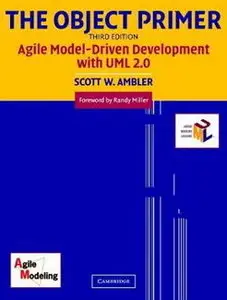April 2024
| Su | Mo | Tu | We | Th | Fr | Sa |
|---|---|---|---|---|---|---|
| 31 | 1 | 2 | 3 | 4 | 5 | 6 |
| 7 | 8 | 9 | 10 | 11 | 12 | 13 |
| 14 | 15 | 16 | 17 | 18 | 19 | 20 |
| 21 | 22 | 23 | 24 | 25 | 26 | 27 |
| 28 | 29 | 30 | 1 | 2 | 3 | 4 |
The Object Primer 3rd Edition
Date: 22 May 2009 19:20:16
The Object Primer is a straightforward, easy-to-understand introduction to agile software development (ASD) using object-oriented (OO) and relational database technologies. It covers the fundamental concepts of ASD and OO and describes how to take an agile approach to requirements, analysis, and design techniques applying the techniques of the unified modeling language (UML) 2 as well as other leading-edge techniques, including agile model–driven development (AMDD) and test-driven development (TDD) approaches.
During the 1990s OO superceded the structured paradigm as the primary technology paradigm for software development. Now during the 2000s ASD is superceding traditional, prescriptive approaches to software development. While OO and ASD are often used to develop complex systems, learning them does not need to be complicated. This book is different from many other introductory books about these topics—it is written from the point of view of a real-world developer, someone who has lived through the difficulty of learning these concepts.
This book is aimed at two primary audiences—existing developers and university/college students who want to gain the fundamental skills required to succeed on modern software development projects. Throughout this book I use the term "developer" broadly: a developer is anyone involved in the development of a software application. This includes programmers, analysts, designers, business stakeholders, database administrators, support engineers, and so on. While many people would not include business stakeholders in this, my experience is that active business stakeholder involvement is often the key determinant to the success of a software project. Business stakeholders can actively participate in requirements engineering, analysis, and sometimes, in design—it is clear to me that they should be considered developers. Call me a radical.
In this book, you will find a survey of the latest software development techniques and a wealth of knowledge to get you started on the road to agile. Those new to this community will find an overview of the critical areas of the agile software movement. This book will help you become more productive. The agile principles inside will change the way that you view software development and, ultimately, the way you build software.
TABLE OF CONTENT:
Chapter 01 - Leading-Edge Software Development
Chapter 02 - Understanding the Basics–Object-Oriented Concepts
Chapter 03 - Full Lifecycle Object-Oriented Testing (FLOOT)
Chapter 04 - Agile Model–Driven Development (AMDD)
Chapter 05 - Usage Modeling
Chapter 06 - User-Interface Development
Chapter 07 - Supplementary Requirements
Chapter 08 - Conceptual Domain Modeling
Chapter 09 - Business Process Modeling
Chapter 10 - Agile Architecture
Chapter 11 - Dynamic Object Modeling
Chapter 12 - Structural Design Modeling
Chapter 13 - Object-Oriented Programming
Chapter 14 - Agile Database Development
Chapter 15 - Where To Go From Here



